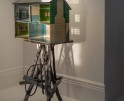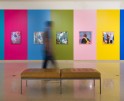Collectors’ Favorites: Stories on why we collect photographs
Years ago, when I was just starting my photo journey, I was invited to an Aperture Collectors’ Brunch. I was excited to meet collectors, naively thinking this might be a good thing for my career as a photographer. As it turned out, it was indeed a good thing, as I learned a lot that day. I learned that most dedicated collectors have a narrow focus on what they acquire. My brunch companions collected photographs of bi-planes and images of Einstein – very specific collections that were not at all what I could have predicted. And now, I too have my own focus in collecting work. No matter how much I appreciate a wide range of photography, the work that continues to draw my attention has qualities that are similar.
The Photographic Arts Council · Los Angeles shared a terrific exhibition at the Rose Gallery in Santa Monica, Collectors’ Favorites, featuring photographs from collector’s own walls, with accompanying essays on what compelled them to purchase those images. This insightful exhibition has had a tremendous response from the community giving the audience a glimpse into not only what we collect, but what draws us to the work in the first place.
Over 70 artworks, ranging from early photographs to works of the present day were on exhibition featuring such masters as Robert Frank, Irving Penn, Imogen Cunningham and Edward Weston, as well as new and vintage works by artists championed by PAC · LA collectors, including works by Lee Friedlander, Augusta Wood, Mary Ellen Mark, Torbjøn Rødland, Nick Waplington, Clarence Sinclair Bull, Dulce Pinzón, Rinko Kawauchi, Margaret Bourke-White, and dozens more.
What follows is a sample of some of the featured works and words behind the Collectors’ Favorites.
Carol Lee Brosseau Collection
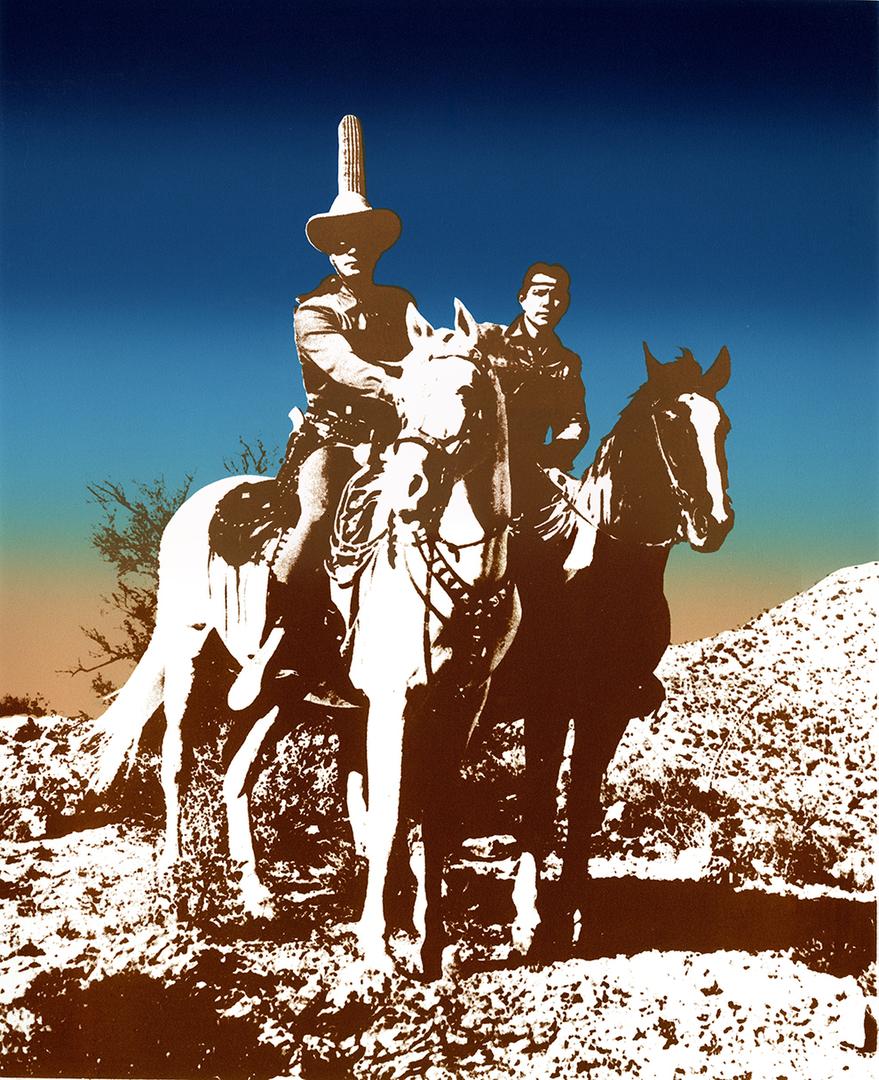
Carol Lee Brosseau Collection ©Betty HAHN (American, b. 1940) Taos Sky 1979 Vintage photo-lithograph
Taos Sky is part of series Betty Hahn’s Lone Ranger Series (1974-79) in which she appropriated a still photograph of The Lone Ranger and Tonto and produced it in a variety of photographic and printing processes. Hahn is best known for her early experimentation with alternative photographic processes and is among one of the first photographers to successfully combine photography with other media. The Lone Ranger series incorporates different process variations of the same images including gum-bichromate, cyanotypes, Van Dyke brown prints, lithography, photo silkscreens, hand-painting, and embroidery on fabric.
I have loved Betty’s work for a long time and am inspired by her early pushing of the traditional boundaries of the photographic medium. However, the focus of my collection is work made in Los Angeles or by Los Angeles photographers. I ultimately justified the addition of Taos Sky to my collection by the fact that the source image relates to Hollywood. It’s a stretch…but I decided to push my own boundaries a little for this one…
Jo Ann Callis Collection
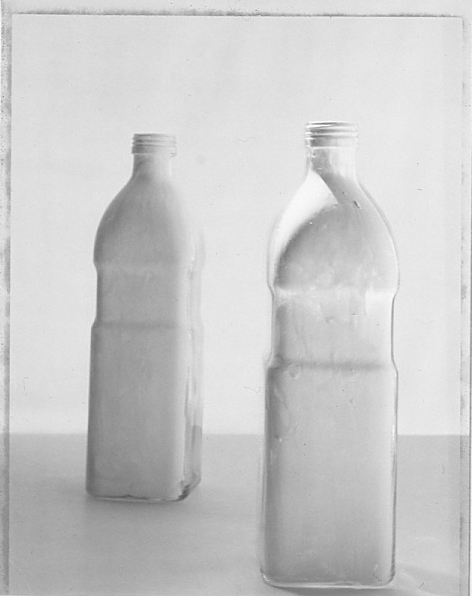
Jo Ann Callis Collection ©Miki WARNER (American, b. 1932) Untitled (still life with 2 bottles), 1985 Gelatin Silver Print
Miki Warner was a graduate student at Cal Arts in 1985 when she made a series of still-lives influenced by the painter Giorgio Morandi, 1880-1964. These simple still life photos of painted bottles emphasize the subtle formal attributes of a balanced composition and the subtle tonalities achieved through careful lighting. The bottles become almost monumental and stately because of their enlarged scale, transforming the subject matter from common everyday objects to assertive abstract shapes that command our attention.
This photograph was given to me in the mid-1980’s. I personally enjoy works that transform the commonplace into something special through art making.
The Conger Family Collection
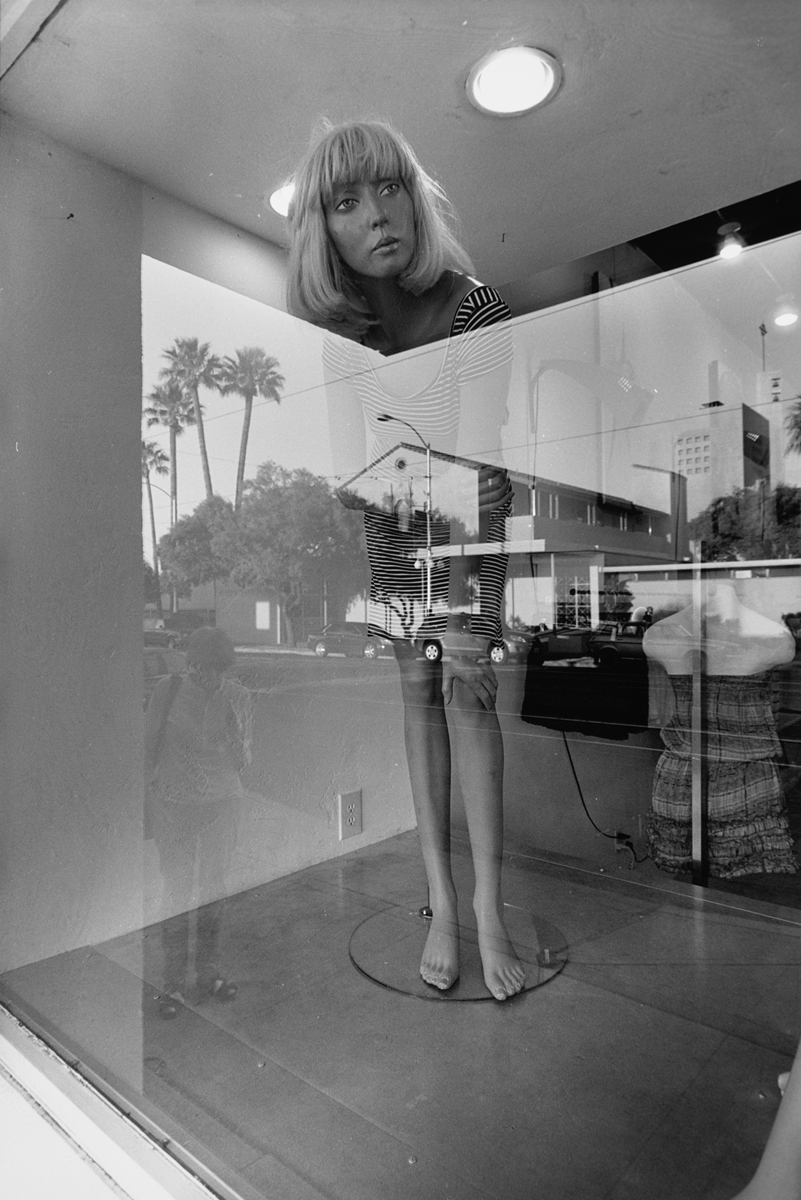
The Conger Family Collection ©Lee FRIEDLANDER (American, b. 1934) Mannequin Tucson, 2011 Gelatin Silver Print
This mannequin image is quintessential Friedlander with its playful, complex, and interrupted composition. It captures his mastery of mixing reflections and geometry along with a strong sense of wit about a subject. The outside landscape of a bystander looking inwards, the apartment building across the street and palm trees are all angling themselves into the store window. Our life-like mannequin is curious about the world outside her shop. Unlike a traditional mannequin, she is bent over with hands on her knees. Her face conveys a ‘what’s happening?’ look. The outside’s reflected and inverted images create another ‘window frame’ within the shop window over which the mannequin peers. We love this particular image because it captures so many of Friedlander’s trademarks: brightness and shadows, sharp geometric angles, double image effects, and a witty human subject. We have always admired Lee’s work especially the small screens, but the mannequins came with more layers of complexity. We couldn’t resist acquiring this particular image where the mannequin itself seemed so human!
Paula Ely & Cesar Rueda Collection
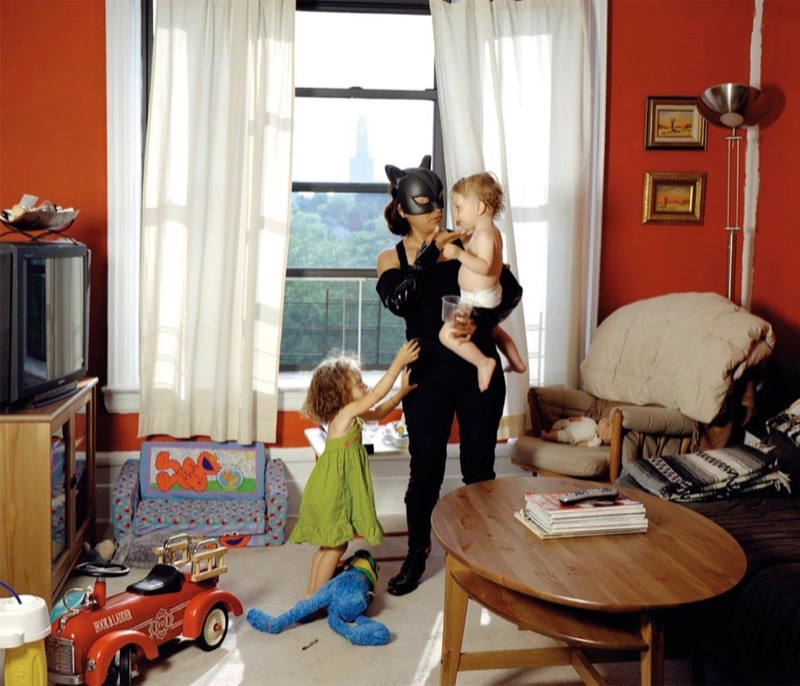
Paula Ely & Cesar Rueda Collection, ©Dulce PINZÓN (Mexican, b. 1974) “Catwoman” is Minerva Valencia, 2011 C-Print Mounted on Sintra
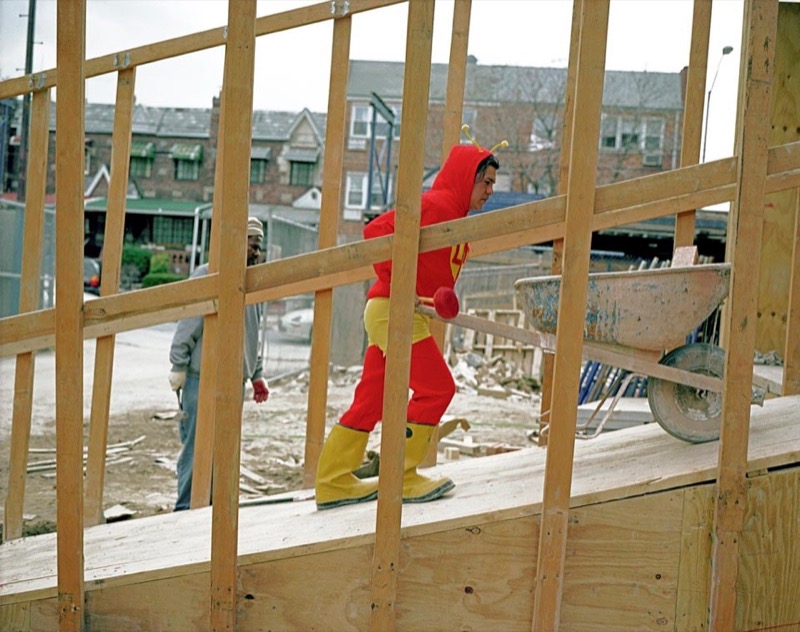
Paula Ely & Cesar Rueda Collection, ©Dulce PINZÓN (Mexican, b. 1974) “Chapulin Colorado” is Adalberto Lara, 2011 C-Print Mounted on Sintra
Immigrant. Wetback. Beaner. Lazy. Criminal….
These were among the words I frequently heard growing up in the suburbs of Los Angeles. Not just on television or at a distance, but directed at me, about me, because of what I am…Mexican. An “Illegal” for several years as a matter of fact. Beyond the everyday struggles of life most people already endure, there’s a burden carried by all people of color in the United States. It works away at you, and you try to restore your spirit every now and again, but it somehow just continues to chip away.
When I first came across Dulce Pinzón’s series, Superheroes, something connected with me right away. Her images exude a crafted exchange of playfulness and wit, yet at the same time are quite serious in nature. The use of bright colors captures the attention, while having several focal points throughout the frame forces the eye to bounce around the photograph (perhaps mimicking the hectic lives of the individuals she’s portraying). She often places her subject dead center, to eliminate all doubt that this is the focal point of her story. Yet the story she is telling is unlike the one many are accustomed to hearing. It’s a story not about lazy criminals, but of what she deems to be the real “superheroes” of society. These two workers have left their homes and families behind in Mexico to travel to New York as part of the immigrant labor force, and they send the bulk of their earnings home to support those back home. They are making incredible sacrifices, and are true heroes in the eyes of their friends and families.
Catwoman – Minerva Valencia from Puebla. Works as a nanny in New York she sends 400 dollars a week.
Chapulin Colorado – Adalberto Lara from the State of Mexico. Works as a construction worker in New York he sends 350 dollars a week.
Some have criticized the work as magnifying the exploitation that her subjects already face on a day-to-day basis. Some feel that dressing up workers in costumes is humiliating, and does nothing more than serve Pinzón’s career. But I disagree with such critics. Latinos are already being exploited and marginalized on a daily basis; there is no escaping that. (To this day, I’m occasionally mistaken for the gardener, or the waiter, or the valet.) What makes these photographs successful in my eye is that Pinzón magnifies our societal perception of Latinos as “the others” in such a way as to expose the very contradictory roles we are perceived to play. Minerva is seen simultaneously as the villain and the maternal figure. Adalberto is the buffoon and the Sisyphean tragedy. They are those we do not want around, yet they are one and the same as those we cannot live without.–Cesar Rueda
Carol Fenelon Collection
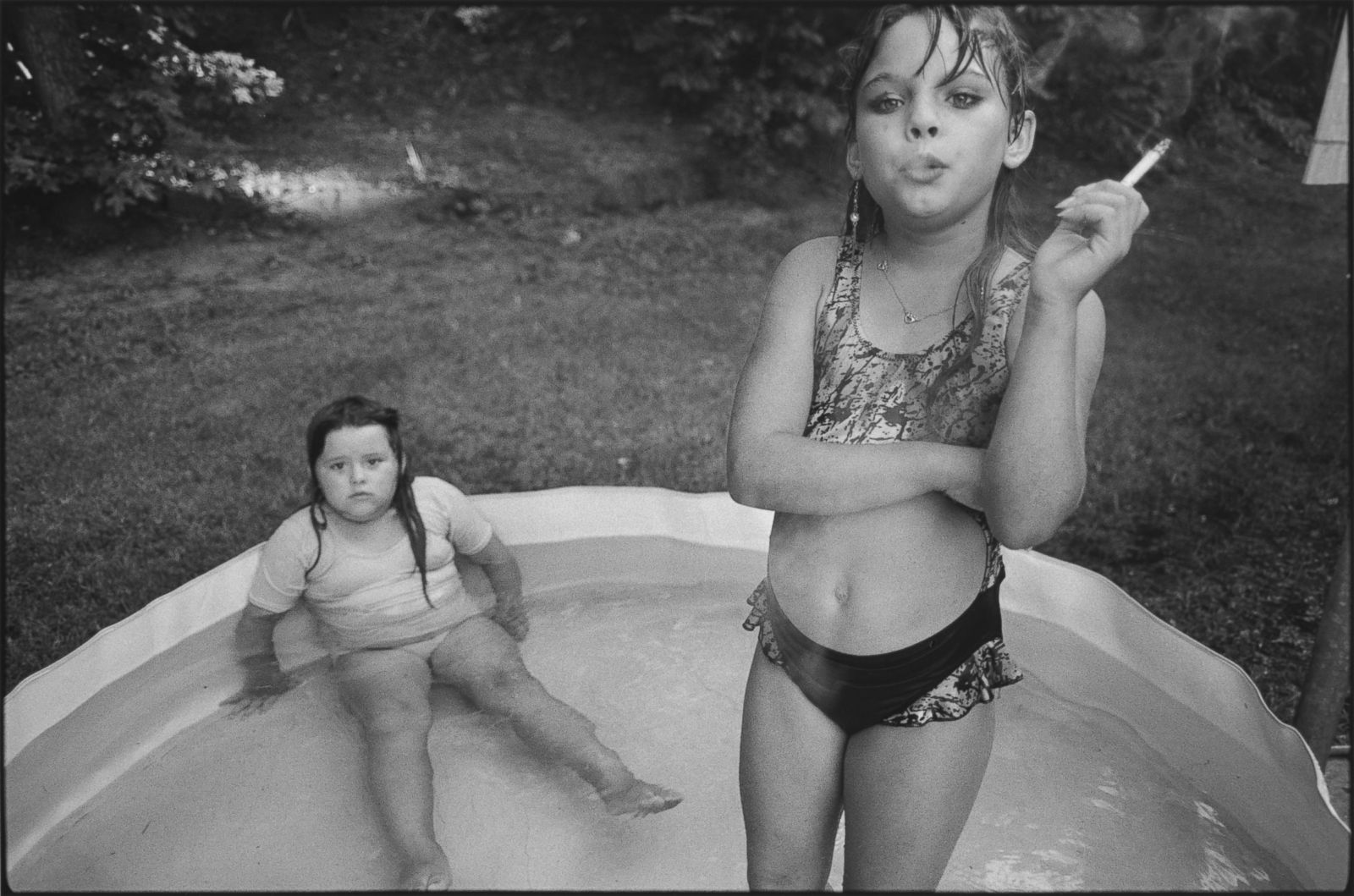
Carol Fenelon Collection, ©Mary Ellen MARK (American, 1940-2015) Amanda and Her Cousin Amy, Valdese North Carolina, 1990 Gelatin Silver Print
If there is a theme to my collection, it’s the desire to reconnect with significant memories or emotions from my past.
When I was eight years old, my parents moved our family from an idyllic life on a Golden Isle in Georgia to a landlocked cracker town in South Carolina. I was bored. Mischief ensued. Filching Kents from my mother’s purse. Sampling sources of intoxication from my father’s liquor cabinet. The girl scouts deemed me a trouble maker and tossed me out of the troop.
The first time I saw the insouciant defiance that Mary Ellen Mark captured in Amanda’s face and stance in this photograph, I recognized myself and laughed. I still have no remorse for my delinquency.
Nancy Hardin Collection
I was lucky enough to have had Alia Ali and her mother Fawzia as the most gracious and generous tour guides imaginable while visiting Marrakesh and I have been following Alia’s peripatetic creative path ever since.
Born in Austria in 1985, Alia is a Yemeni-Bosnian-American multi-media artist who has traveled to 53 countries and lived in seven, growing up among five languages. So it’s probably not surprising that she is most comfortable communicating visually, through images and multi-sensory mediums.
The theme of her work in this series, “Cast No Evil,” is boundaries – what divides and what unites us. By creating portraits she calls “’cludes,” she questions the fabricated barriers in society that inhibit the incorporation of others and asks us to consider, more specifically, which side of the fabric we are on and if we can be on both sides simultaneously. The material creates a boundary but who holds the power: the one covered, in their anonymity, or the observer? Ultimately, who are the “includes” and who are the “excludes”?
I like knowing that it is Alia who is covered up in all of the portraits in this series, so in a way this ’clude, “Dots II,” is also self-portrait of the artist.
Michael Hawley Collection
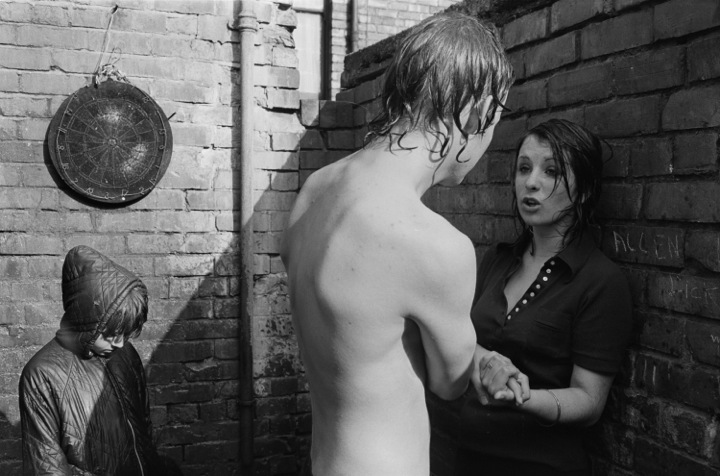
Michael Hawley Collection ©Sirkka-Liisa KONTTINEN (Finnish, b. 1948) Young Couple in a Backyard, Byker, 1975 (printed later) Gelatin Silver Print, Courtesy L. Parker Stephenson Photographs, NYC
This photograph was taken in the town of Byker near Newcastle in Northern England. The photographer is a co-founded the Amber Collective in 1969, a group whose aim it was to document and give voice to the working class and marginalized communities in the region through film and photography.
This territory, both physically and metaphorically, has been well covered by such celebrated artists as Chris Killip and Graham Smith, even Martin Parr (all part of this Collective at some point). Unlike her compatriots, Konttinin has explored this world by focusing on its women. She says to us, the lives here are not only about the rust and the drink, the coal dust and damp. She says, real things happen here, there is distress, but also compassion. There is love here. Look!
What is going on in this strange, beautifully realized photograph? It seems to me that something has gone very wrong… but notice the woman’s steadying hand, the unlikely bright sunlight. Look… everything will be okay.
Gloria Katz & Willard Huyck Collection
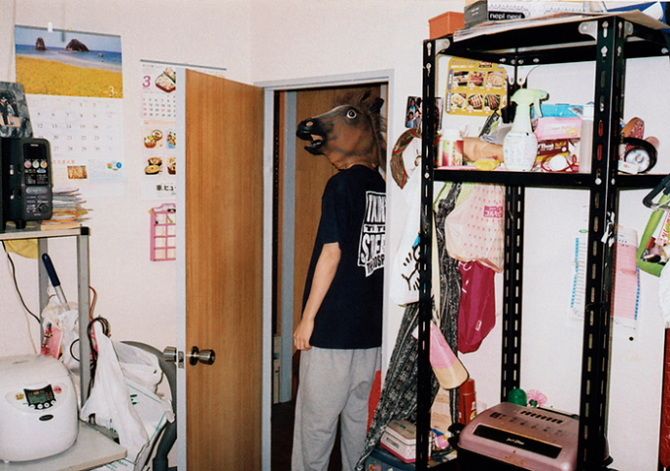
Gloria Katz & Willard Huyck Collection ©Motoyuki DAIFU (Japanese, b. 1985), Horsehead in Doorway. 2009 Chromogenic print
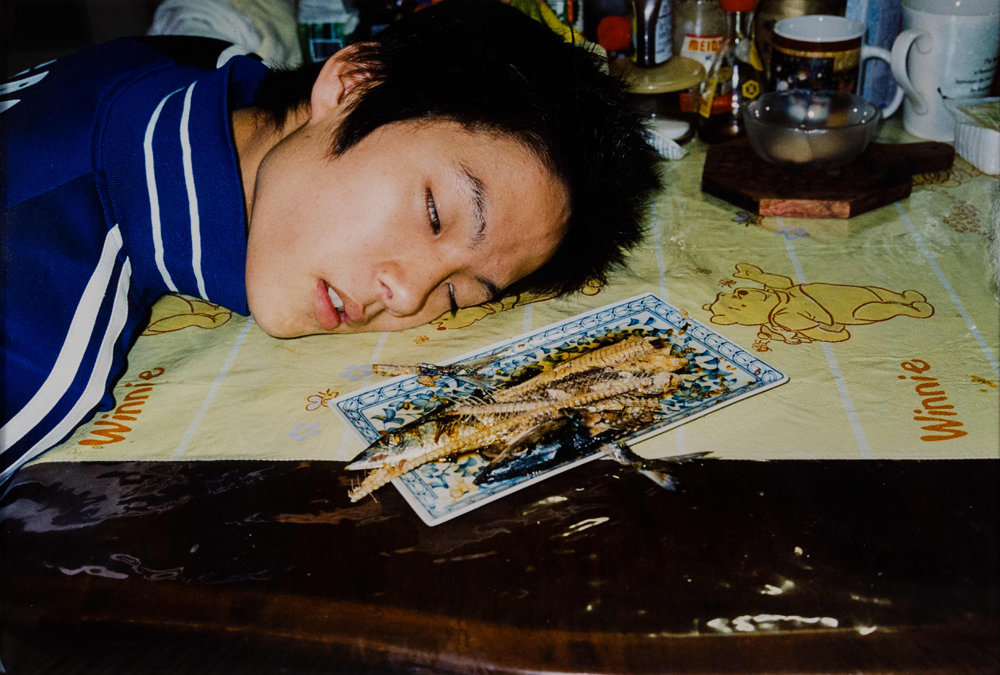
Gloria Katz & Willard Huyck Collection ©Motoyuki DAIFU (Japanese, b. 1985), Asleep With Fish. 2009 Chromogenic print
“My mother sleeps every day. My dad does chores. My brothers fight. There are trash bags all over the place. Half-eaten dinners, cat poop, mountains of clothes: this is my lovable daily life, and a lovable Japan.” – Motoyuki Daifu
Motoyuki Daifu’s color-cluttered, snapshot-style pix reveal a Yokohama house crammed with too many gross relatives and too much nasty stuff. And he titles his tabloid-tableaux “My Family is a Pubis, so I cover it in Pretty Panties.”
Daifu’s goofy series may not represent the gestalt of all family life in Japan today, but it is definitely an indication of the new directions in Japanese photography. People often think Japanese photography is still black and white and high contrast like the iconic work of Hosoe, Moriyama and Tomatsu – which is like saying American music is still like Presley, Dylan, and Chuck Berry.
At present, art photography in Japan is going off in different directions and all over the map stylistically. Mixed media art pieces; mega-big prints that amateurs can’t D.I.Y. at home; the revival of old techniques and alternative processes; and new avenues of experimental and conceptual work.
We were about to comment on Daifu’s break with the traditional Japanese sense of privacy – and how in Japan you aren’t often invited into a person’s home. Then we remembered our daughter in Oakland doesn’t often invite us in either. We’ll usually meet at a nice café. Which is probably best if you’ve ever seen our daughter’s place – or Motoyuki Daifu’s.
George Legrady Collection
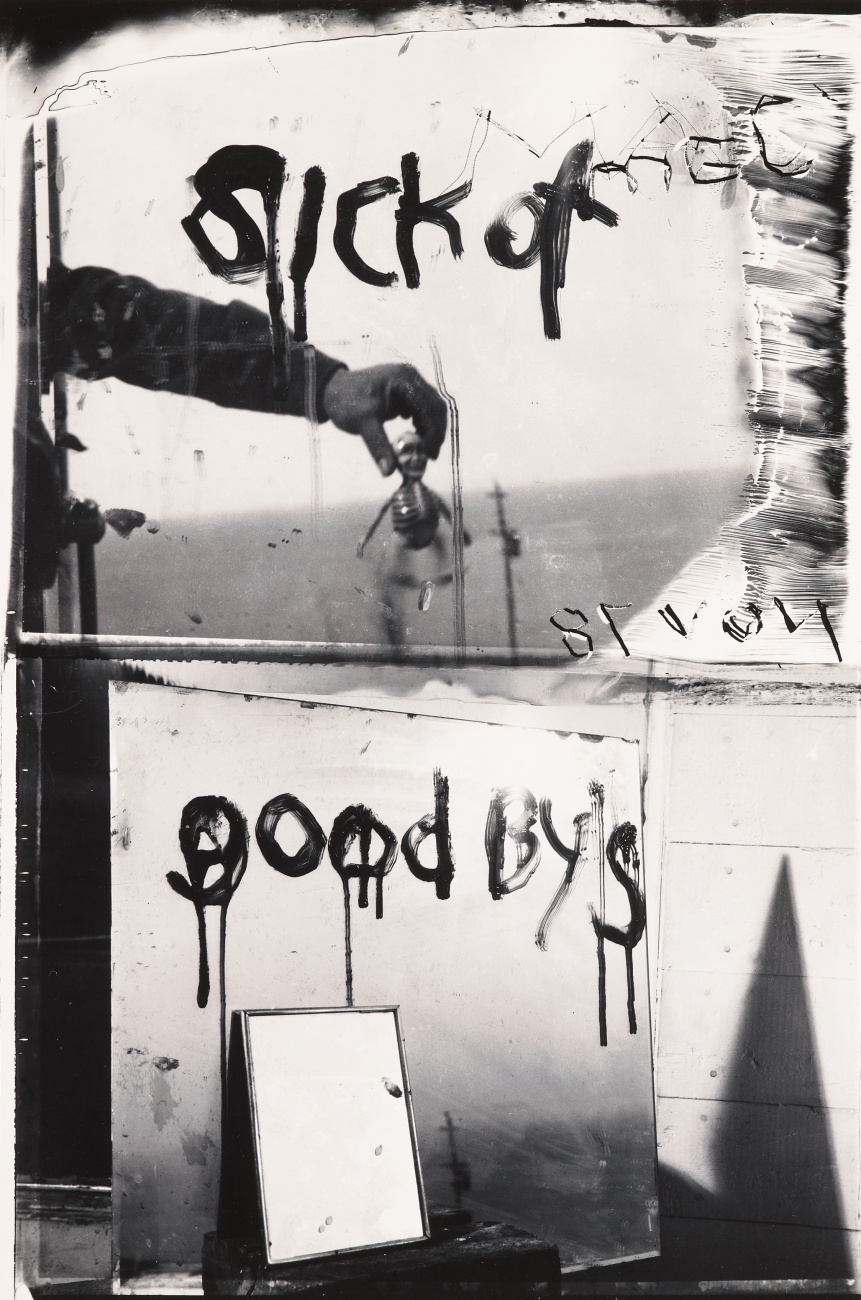
George Legrady Collection ©Robert FRANK (American, b. 1924) Sick of goodbys, Mabou, 1978 Gelatin Silver Print
Prior to graduate studies at the San Francisco Art Institute, I had begun my photographic studies in Montreal, under the guidance of painter/photographer Charles Gagnon and photographer John Max at Loyola College. Both were associated with Yajima Galerie, in Montreal, directed by Michiko Gagnon. The gallery had an exceptional exhibition program, beginning in the mid-1970s, featuring painting and photography concurrently by leading Canadian artists. As a young artist, I was fortunate to have had two solo exhibitions at Yajima in the early 1980s.
Canadian photography art historian, Penny Cousineau-Levine assembled a limited edition portfolio in the late 1970s, inviting 17 Canadian photographers to participate by each contributing an image. I participated with a gelatin silver print titled “Log supported by two poles” created in 1975. Each of the participants received a full set of the portfolio. Titled “Canadian portfolio,” many of the works were contributed by photographers associated with Yajima Galerie, including Robert Frank who was represented by the gallery in Canada with a solo exhibition in 1977. I believe his contribution “Sick of Goodbys,” realized in 1978, addressed a personal family tragedy.
Mary Maffei Collection
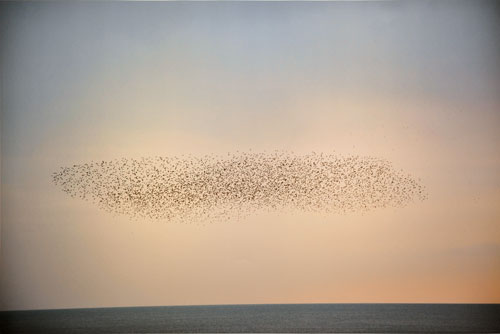
Mary Maffei Collection ©Rinko KAWAUCHI (Japanese b. 1972) Untitled (Starlings over Brighton), 2010 Archival Pigment Print
I have always had a fascination with starlings. Their murmurations are a mesmerizing wonder of nature. The movement is so graceful and gives one a sense of suspended reality. Rinko captured these starlings in magical light. I wanted to have this beautiful photograph in my bedroom to lull me to sleep!
Craig Manning Collection
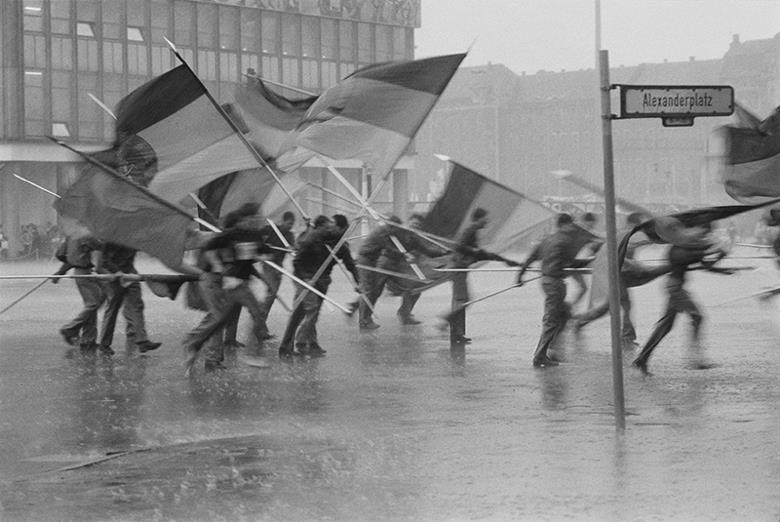
Craig Manning Collection ©Harald HAUSWALD (German, b. 1954) May First Demonstration, Alexanderplatz, 1987 Gelatin Silver Print
Harald Hauswald was interested in the world of young people in East Germany. It makes sense that he is present as youthful standard bearers collect in Alexanderplatz on May Day. Suddenly, a heavy downpour wreaks havoc. I love how this picture captures the chaos of the moment and the breakdown of ritual – the blurred image of boys attempting to escape the deluge, flags in disarray, motion amplified by the still clarity of the street sign. Less than three years before the Wall will come down, disruption and turmoil loom.
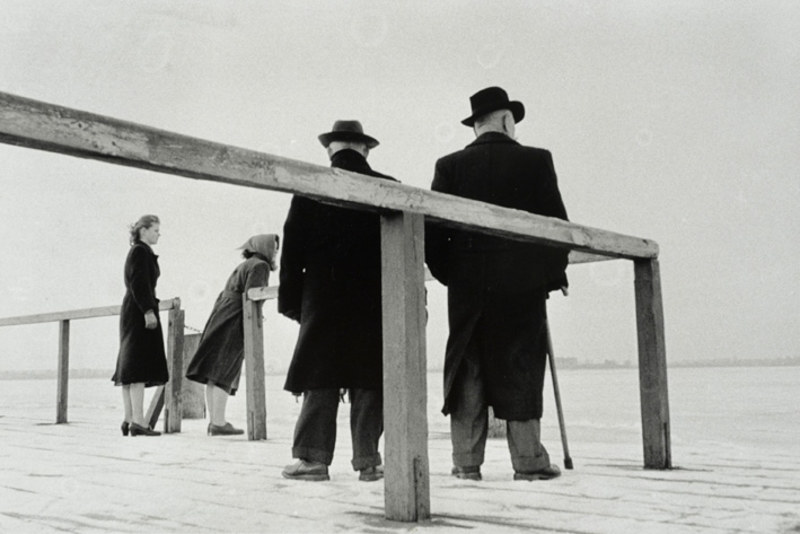
Craig Manning Collection ©Arno FISCHER (German, 1927-2011) Müritz, 1956, printed 1980s Gelatin Silver Print
Photographers in communist East Germany gained compass to do their work by portraying the nominal normalcy of daily life. Fischer shows four figures taking in the view of Lake Müritz, north of Berlin, perhaps on a weekend drive up from the city. The year is 1956, half a decade before construction of the Berlin Wall, but a time when the fortified inner border between the two Germanys had begun restricting travel to the west. I am drawn to this photo for how it can be read as signaling emerging peril. The blustery winter day, a dusting of snow, the boundary fence, and a sense of watching and waiting provide ominous subtext to the otherwise quotidian moment.
Teleia Montgomery Collection
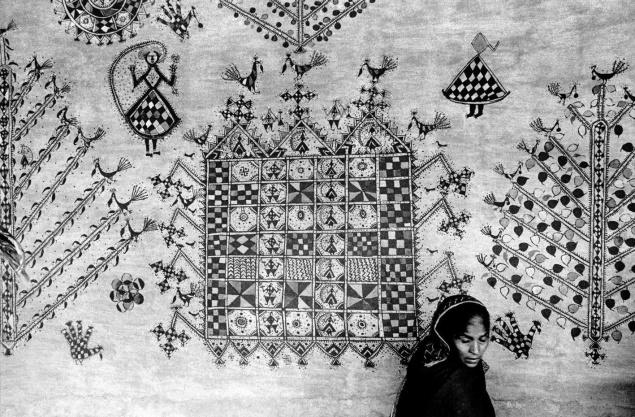
Teleia Montgomery Collection ©Jyoti BHATT (Indian, b. 1932) Women Making a Samha Devi Image, Haryana, 1977 (printed later) Gelatin Silver Print
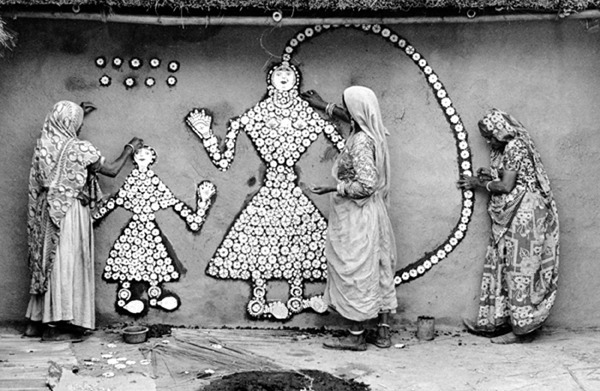
Teleia Montgomery Collection ©Jyoti BHATT (Indian, b. 1932) Rajasthan, 1988 (printed later) Gelatin Silver Print
A couple of years ago at Paris Photo, my friend M. Le Huge and I walked into a booth neither of us knew. On the wall were photos that caught my eye right away because I had no idea what I was looking at.
One particular photo caught my eye right away. I thought it was some sort of futuristic image, but upon a closer look I discovered it was three women making a very large detailed white design of Sahma Devi on a wall in rural India. I love how they appear to be so serious and adoring in their efforts.
Another photograph in the same booth also caught my attention: a single woman in black with her back to a wall decorated with many black detailed designs including a small Sahma Devi image. I liked the contrast between the two photos, the first of a group of women and the one large white image, the second, a single woman with many small images in black.
Although the artist, Jyoti Bhatt is celebrated in India (a place I’ve been lucky enough to visit), he was unfamiliar to me. Today his beautiful work is on my wall, a piece of India, brought into my home.
Marjorie Ornston Collection
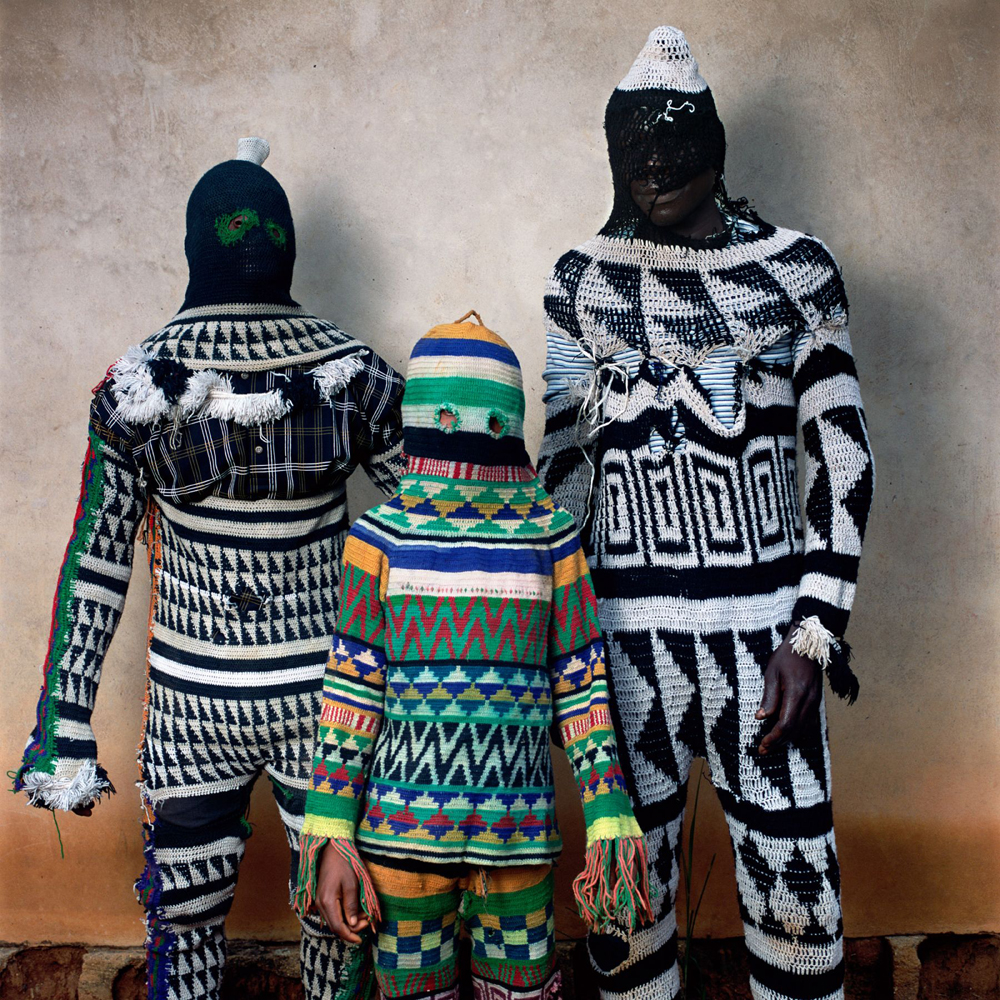
Marjorie Ornston Collection ©Phyllis GALEMBO (American, b. 1952) Atal Masquerade, Emanghabe Village, Nigeria, 2004 C-Print
For over twenty-five years, Phyllis Galembo has documented cultural and religious traditions around the world – India, Mexico, South America, Haiti, and often Africa and the African Diaspora. Her subjects are participants in masquerade events — traditional ceremonies and carnivals — who use costumes, body paint and masks to create remarkable and otherworldly characters. Mostly bizarre and unexpected, yet often dark and frightening, her straightforward portrait style turns a wacky and weird figure into a mythic icon, powerfully portraying the transformational power of the mask.
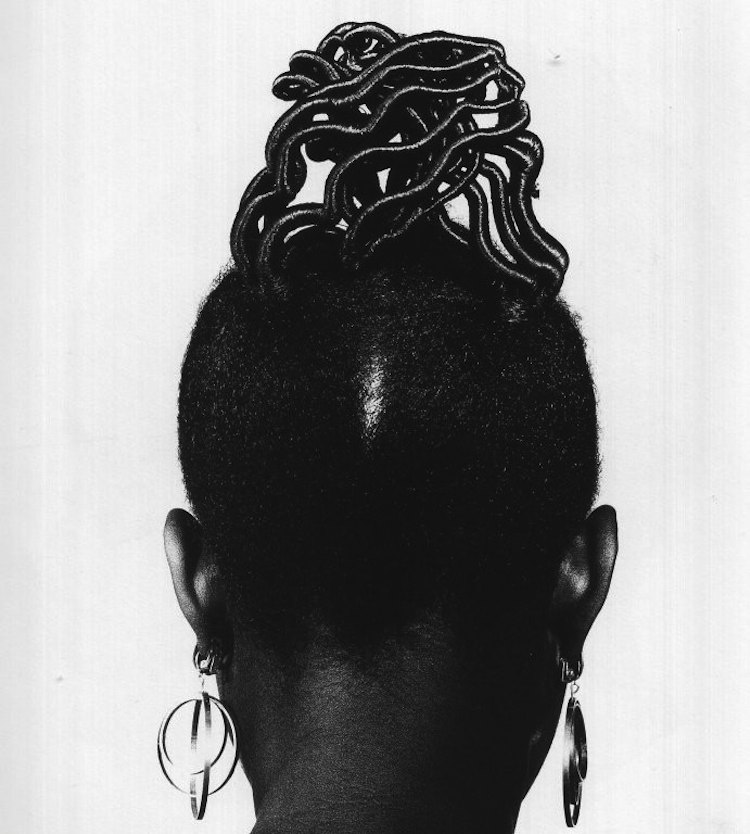
Marjorie Ornston Collection ©J.D. ‘Okhai OJEIKERE (Nigerian, b. 1930) Untitled (Suku Sinero/Kiko), 2010 Gelatin Silver Print
Ojeikere was a forerunner of the practice of documentary photography in Nigeria. Beginning in the 1950s, he produced a deep and striking portfolio of two thousand images documenting the ways women styled their hair into monumental headdresses. His photographic vocabulary is immediately recognizable: lack of backdrops or props, elegant female sitters, elaborate coiffures, soft lighting, immaculate black-and-white printing. In his hands, photographs became a means to record the transient creativity that articulated Nigerian social and cultural life.
Stephen Reinstein Collection
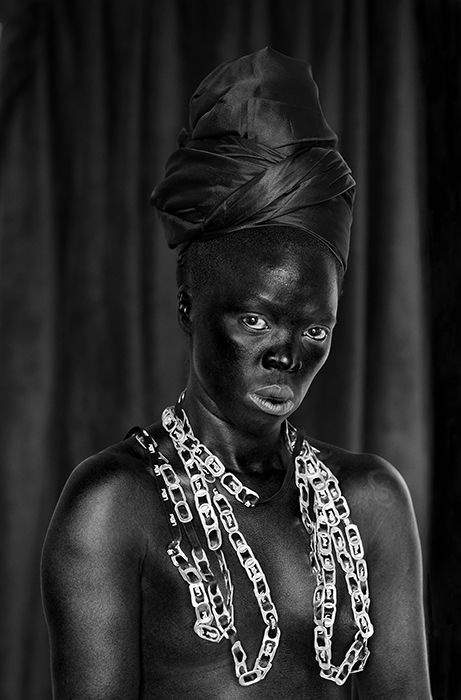
Stephen Reinstein Collection ©Zanele MUHOLI (South African, b. 1972) Thando II Nuoro, Sardinia, Italy, 2015 Gelatin Silver Print
Muholi is a South African artist who I have been following for the past five years. I first discovered her work in San Francisco at an exhibit of South African photography featuring her outstanding portraits of that country’s lesbian and transgender community. Her camera recently turned on herself, and I was thrilled to be able to acquire this recent self-portrait at AIPAD. This haunting photograph veers away not only from traditional glamour or fashion photography, but stereotypical portraits of African women as well. Muholi’s piercing gaze and nude upper torso is accented by a stylish turban on her head and a necklace of aluminum can openers draped like Harry Winston jewelry around her neck, covering her breasts. For a woman who was told how ugly she was growing up, I see nothing but beauty in her maturity and self-possession.
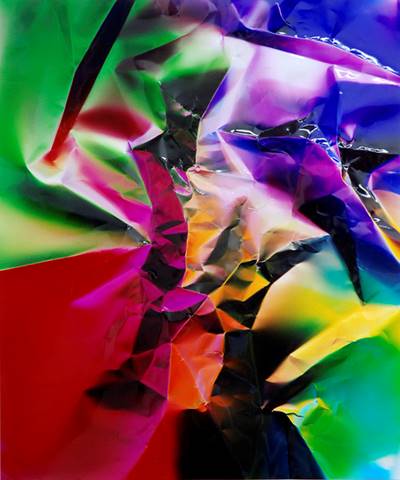
Stephen Reinstein Collection ©Ellen CAREY (American, b. 1952) Dings & Shadows, 2015 Unique, chromogenic print on glossy paper
As a collector whose acquisitions typically do not focus on traditionally beautiful or pretty work, but rather confrontational images with an edge, this Ellen Carey piece with its beautiful jewel tones does represent a departure as far as the image itself. However, this piece is more about process, as she pushes the edges of photography, with unique three dimensionality created via the abstract use of color and manipulation of the paper that the image is printed on. Almost prism-like, I see something different every time I look at it. In Carey’s own words, “Color is subject and object, material with meaning, process within the art.”
Richard & Strawn Rosenthal Collection
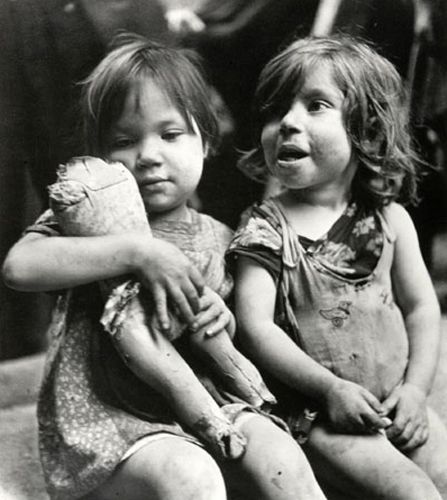
Richard & Strawn Rosenthal Collection ©David SEYMOUR (Polish, 1911-1956) Children, Italy, c.1948 (printed in 1950s) Gelatin Silver Print
This is the photograph that hangs to the left of my desk at home. If I’m not looking out the window, my gaze is in the direction of this photograph. The photographer, David (Chim) Seymour, took it as part of a project “Children of War,” in which he documented the plight of children in the aftermath of World War II. These are children who have been displaced or orphaned by war, who have been traumatized both emotionally and physically. The best-known image in the series is of a young girl who has filled a blackboard with her scribblings in response to the request that she draw a picture of home.
In the photo here, the girl on the right is disturbed and somewhat wild, in contrast to the stillness of the girl next to her, who is holding a headless, featureless remnant of a doll, whom she is looking at with maternal tenderness and love. The photograph speaks about the importance of such a relationship to the healing process, whether from the traumas of war, recovery from addiction, medical illness, or the overcoming of loss. I don’t usually collect photographs this simple, even sentimental, in fact I can’t think of another in our collection. I seem to prefer those showing ambiguity, complicated relationships, people looking past each other, negative spaces, black holes. Yet, somehow, this is the photograph I look at more than any other.
Chim (pronounced Shim), a play on his original Polish surname, was a photojournalist known initially for his images of the Spanish Civil War. Along with his friends Robert Capa and Cartier-Bresson, he co-founded Magnum. It was at a 1967 exhibition, “The Concerned Photographer,” that I first came across his work, along with that of Capa, Werner Bischof, Dan Weiner, and Leonard Freed. Seeing that exhibition was a memorable experience for me. It was also the first time I ever purchased a photograph. –– Richard Rosenthal
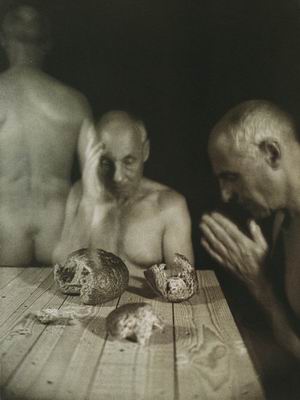
Richard & Strawn Rosenthal Collection ©Jan VAN LEEUWEN (Dutch, b. 1932) The Meal at Emmaus, 1996 Kallitype
Van Leeuwen, a gentile, spent childhood in Nazi-occupied Amsterdam. One by one he witnessed young Jewish friends being taken away never to return. Disappeared. He was left with a haunting sense of sadness, angst, and confusion.
He works in 19c photographic techniques because he feels their grain and diffusion best suit his rendering of uncanny loss, disappearance, and mystery. He uses self-portraiture to intensify the intimacy. In blue cyanotype, he has told the story of the Holocaust in a series of ghost-like self-portraits behind barbed wire. Likewise, working in brown kallitype, he appears in New Testament stories of loss and return and consecration.
This image represents the biblical story of The Meal at Emmaus. Two disciples are on edge having heard that Christ’s tomb is open and his body, disappeared. They meet a stranger on the road and share a meal. As he breaks bread they recognize the stranger as Christ but, at the moment of recognition, he disappears.
The way the figures recede into the distance conveys the sense of time; Christ (?) is breaking bread, praying with the disciples, while also disappearing after having been identified. There is a sense of movement from right foreground to left background conveying past, present, and future, depending upon how the viewer chooses to read it. All three tenses are fused and equally alive. Additionally, the loaf of the bread that somewhat resembles a skull, is an oblique reference as much to the holocaust as to Golgotha.
A profound experience of disappearance is never forgotten. Its meaning forever sought. This image captures an eternal moment of prayerful question. A mystery. A meditation.— Strawn Rosenthal
Annie Seaton Collection
It was love at first sight at Photo la 2007 when I first spotted the Julie Blackmon print “The Babysitter” from her 2006 series Domestic Vacation. Blackmon’s series and her subsequent artworks share elements of humor and strong painterly like compositions and color—plus incorporating children from her own large extended family as subject matter is probably the most important hallmark of her work. Children, Color, painterly compositions are all elements that attract me to photos I collect. I am a painter as well and these themes are equally important and recur in my own work.
Blackmon’s subjects are often arranged like a traditional tableau reminiscent of the great paintings of Europe such as David or Rembrandt but with a very current day twist. She photographs with a painters mind but also with a wink too not taking her compositions or subjects too seriously. “The babysitter” has a strong traditional composition but very Contemporary. Who is the babysitter, is it the young woman in cut off shorts listening to her iPod and not paying much attention to her charges or is it the laptop computer? Why is it titled “The Babysitter” when the young woman is intentionally cropped out but the laptop is smack in the middle? This image is a sign of our times. Technology subtly spotlighted in its new role as babysitter. Everything about this photograph is endearing and funny, the grinning children, the warm interior and the title but it is equally strong and serious too. Just like the photographer, a young woman artist who was at the time, just on the cusp of her meteoric career.
Smithson/Steinway Collection
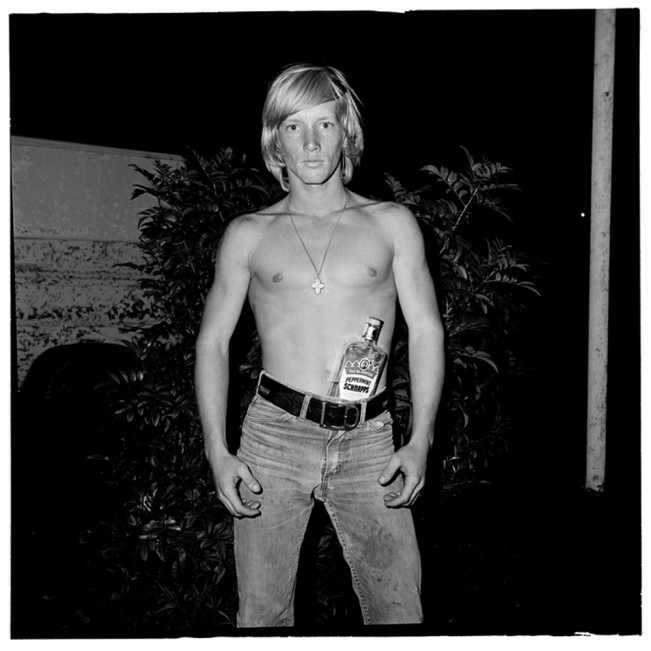
Smithson/Steinway Collection ©Bill YATES (American b. 1946) Schnapps Boy, from Sweetheart Roller Skating Rink, 1972 Silver Gelatin Print
I was particularly drawn to the project, Sweetheart Roller Skating Rink, by Bill Yates because it speaks to a time of innocence and small town swagger–captured during a period of unrest and uncertainty. Schnapps Boy perfectly captures that window of teenage bravado when risk taking and posturing reflect the notion of invincibility and bluster. He is at once masculine and feminine, ready for something to happen.
Knowing that Bill made this work when he was in his early ’20s, at the beginning of his photo career, during a period of time in his own life when going to Vietnam was a possibility, makes the work even more poignant as he observes the next generation on the cusp of adulthood, seemingly oblivious to the bigger picture.
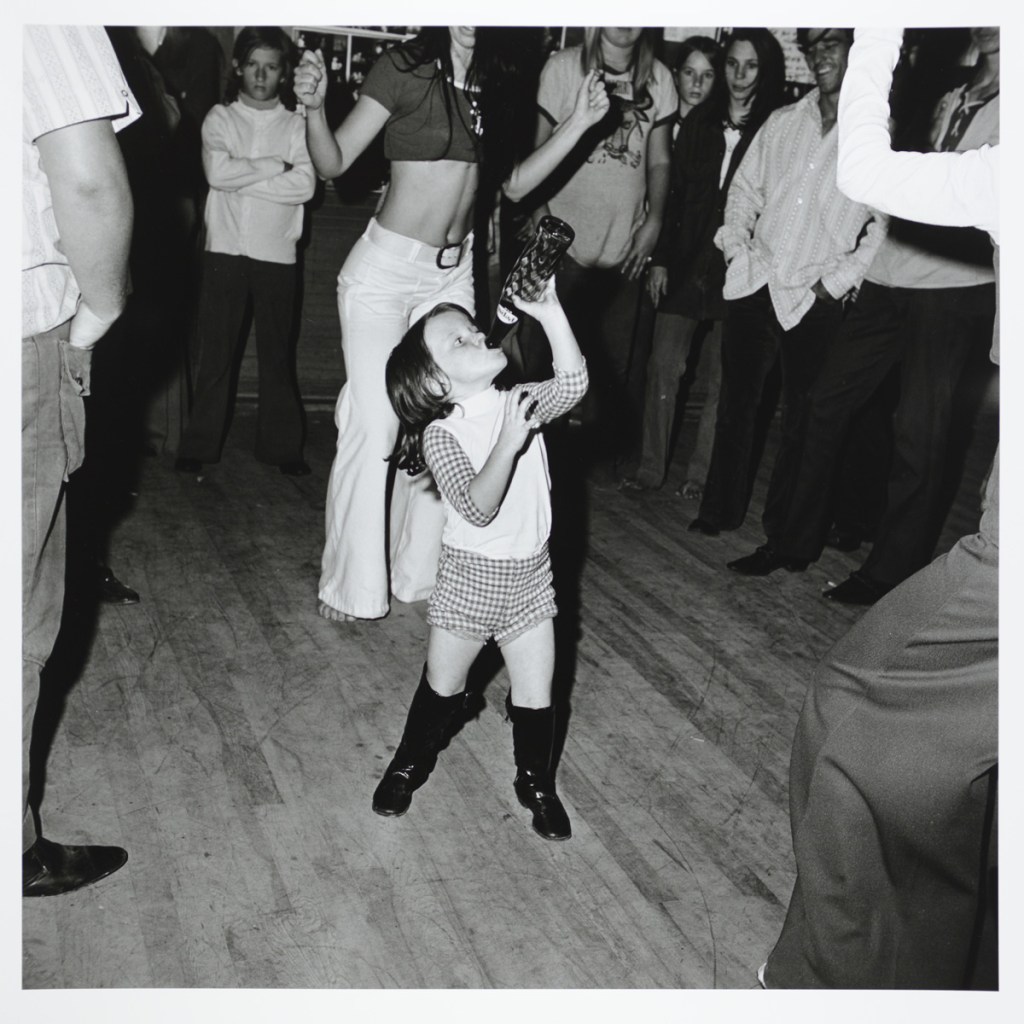
Smithson/Steinway Collection ©Bill YATES (American b. 1946) Pepsi Girl, from Sweetheart Roller Skating Rink, 1972 Silver Gelatin Print
I love the idea of a little sister accompanying an older sibling to a teenage event and the need to prove herself as worthy of being there. Pepsi Girl reflects as much swagger as Schnapps Boy with her knee high boots and manic expression and we know that she will be a handful down the line. There is humor in her efforts to draw attention to herself and I have to admit that I am intrigued by her ability to work the room.
Now in its fourth year as an independent group, the Photographic Arts Council · Los Angeles was founded to foster individual and community-wide knowledge and appreciation of the Photographic Arts. Throughout the year, PAC · LA members are invited to special collection and artists’ studio visits, take part in educational programming, are offered private curator-led walkthroughs, as well as travel opportunities outside Los Angeles. In addition, PAC · LA offers grants in the photographic arts.
Posts on Lenscratch may not be reproduced without the permission of the Lenscratch staff and the photographer.
Recommended
-
Broad Strokes III: Joan Haseltine: The Girl Who Escaped and Other StoriesMarch 9th, 2024
-
Pamela Landau Connolly: Wishmaker and The Landau GalleryFebruary 27th, 2024
-
Janna Ireland: True Story IndexFebruary 17th, 2024
-
Richard McCabe: PerdidoJanuary 7th, 2024
-
Aline Smithson: The Ephemeral ArchiveJanuary 5th, 2024




